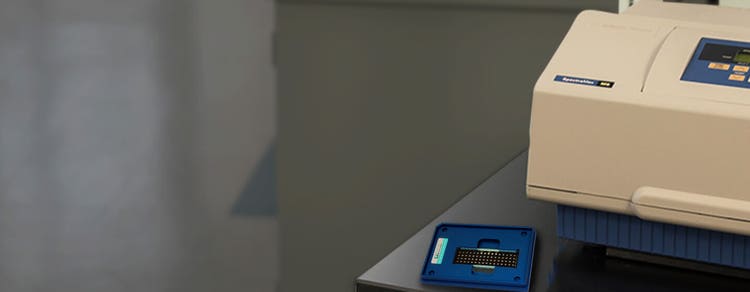
SpectraDrop Micro-Volume Microplate
Smaller, faster quantitation of DNA, RNA, and protein
A micro-volume solution for benchtop microplate readers
The SpectraDrop™ Micro-Volume Microplate offers a high-throughput solution for low-volume measurement. Innovative design features enable accelerated sample preparation time, increased laboratory productivity of DNA, RNA, and protein samples as low as 2 μL, and compatibility with absorbance and fluorescence read modes. The microplate format assures uniform and reproducible analysis and integrates seamlessly with the Molecular Devices StakMax® Microplate Stacker for greater research capacity.

Place droplets precisely
The Teflon slide coating ensures precise droplet placement, while the attached side spacers control for pathlength and evaporation, for a uniform and reproducible data analysis tool.

Clean easily
The two-slide design makes the cleaning process easy. You can quickly wipe, autoclave, sonicate, or simply replace each slide without worrying about any calibration steps.

Get unmatched throughput
With up to 64 sample spaces and compatibility with Molecular Devices StakMax Microplate Stacker, you get a measurement system that offers the highest low volume throughput available today.
Features

Elegant simplicity
The SpectraDrop microplate incorporates a specially designed adapter and a slide pair for a uniform multi-sample assembly. This simplicity allows users to have their own slide combination, ideal for multiuser laboratories.

Unique design
The microplate’s unique design consists of a specially designed adapter, Teflon-coated bottom slide, and top slide with evaporation reducing spacers. It is compatible with 8- and/or 16-channel pipettors.

Easy slide access
The microplate has two side pockets for easy slide access and tight slide tolerances for a no-smear experience.

Versatility
The microplate comes in two density configurations, 24-wells per plate and 64-wells per plate, and two volume options, 2 or 4 μL, allowing users to select their ideal configurations.
Latest Resources
Specifications & Options of SpectraDrop Micro-Volume Microplate
* dsDNA sensitivity specified for the following instruments:
- SpectraMax® 190 Microplate Reader
- SpectraMax® Plus 384 Microplate Reader
- SpectraMax® i3 Multi-Mode Detection Platform
- SpectraMax® M Series Multi-Mode Microplate Readers
- SpectraMax® Paradigm® Multi-Mode Microplate Reader
- FlexStation® 3 Multi-Mode Microplate Reader
- SpectraMax® ABS Absorbance Reader
- SpectraMax® ABS Plus Absorbance Reader
- Gemini™ XPS Microplate Readers
- Gemini™ EM Microplate Readers